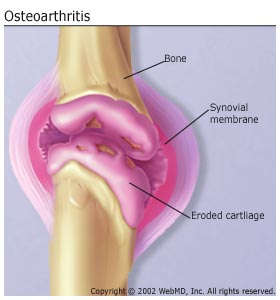Arthritis
Arthritis ('arth' meaning joint, 'itis' meaning inflammation) isn't a one-note story or even a few variations on a single theme; it actually consists of more than 100 different conditions. These can be anything from relatively mild forms of tendinitis (as in 'tennis elbow') and bursitis to crippling systemic forms, such as rheumatoid arthritis. There are pain syndromes like fibromyalgia and arthritis-related disorders, such as systemic lupus erythematosus, that involve every part of the body. There are forms of the disease, such as gout, that almost nobody connects with arthritis, and there are other conditions - like osteoarthritis, the misnamed 'wear and tear' arthritis - that a good many people think is the only form of the disease.
Osteoarthritis (OA)

The main symptoms are pain and restricted movement. The pain is chronic pain or gives varying amounts of discomfort when standing and walking. Pain is generally described as aching, sharp, or a burning sensation in the associated muscles and tendons, and includes loss of mobility and often stiffness. Humid weather increases the pain in many patients. Patients can experience muscle spasm and contractions in the tendons. OA can cause a crackling noise (called crepitus) when moved or palpated. Occasionally, affected joints may fill with fluid. Some develop Heberden's nodes and/or Bouchard's nodes in the fingers when these are affected.
The joints mainly affected by OA are the hip joints and the knee joints, although in theory any joint in the body can be affected. OA can affect the fingers, the spine, and the shoulder.
The diagnosis is made on the basis of the history, physical examination (restricted movement, crepitations) and X-rays of the joints. Occasionally, MRI (magnetic resonance imaging) may be required to examine the extent of the damage, especially in the spine. Imaging techniques can reveal damaged cartilage, loss of joint space, or bone spurs indicating the presence of osteoarthritis.
Causes of OA:
There are several factors that increase a person's chances of developing osteoarthritis.
These include:
Osteoarthritis affects about one in every seven Americans. The chance of developing the disease increases with age. Most people over age 60 have osteoarthritis to some degree, but its severity varies. Even people in their 20's and 30's can get osteoarthritis.
Rheumatoid Arthritis (RA)
Rheumatoid arthritis (rue-ma-TOYD arth-write-tis) involves inflammation in the lining of the joints and/or other internal organs. RA typically affects many different joints.
It is typically chronic, which means it lasts a long time, and can be a disease of flare-ups.
RA is a systemic disease that affects the entire body and is one of the most common forms of arthritis. It is characterized by the inflammation of the membrane lining the joint, which causes pain, stiffness, warmth, redness and swelling. The inflamed joint lining, the synovium, can invade and damage bone and cartilage. Inflammatory cells release enzymes that may digest bone and cartilage. The involved joint can lose its shape and alignment, resulting in pain and loss of movement.
Symptoms include inflammation of joints, swelling, difficulty moving and pain.
Other symptoms include:
Loss of appetite
Fever
Loss of energy
Anemia
Causes of Rheumatoid Arthritis:
The exact cause of rheumatoid arthritis is unknown, but it is thought to be due to a combination of genetic, environmental and hormonal factors. With rheumatoid arthritis, something seems to trigger the immune system to attack the joints and sometimes other organs. Some theories suggest that a virus or bacteria may alter the immune system, causing it to attack the joints.
Research hasn't been able to determine exactly what role genetics plays in rheumatoid arthritis. However, some people do seem to have a genetic or inherited factor that increases their chance of developing rheumatoid arthritis.
Other features include lumps (rheumatoid nodules) under the skin in areas subject to pressure (e.g., back of elbows).
Rheumatoid arthritis affects 2.1 million Americans, mostly women.
Onset is usually in middle-age, appears more frequently in older people, but also affects children and young adults
1.5 million women have rheumatoid arthritis compared to 600,000 men .
Early in the disease, people may notice general fatigue, soreness, stiffness and aching. Pain and swelling may occur in the same joints on both sides of the body and will usually start in the hands or feet. RA affects the wrist and many of the hand joints, but usually not the joints that are closest to the fingernails (except the thumb). RA also can affect elbows, shoulders, neck, knees, hips and ankles.
It tends to persist over prolonged periods of time, and over time, inflamed joints may become damaged.
#############################
LINKS
Arthritis Foundation Home Page:
About Arthritis :
(your questions answered about the different types of arthritis)
(National Institute of Arthritis and
Musculoskeletal and Skin Diseases)
(this one may seem strange, but it is a good resource)
#############################